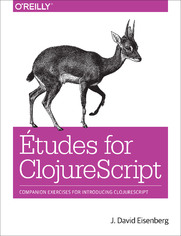Etudes for ClojureScript - Helion

ISBN: 978-14-919-5230-6
stron: 129, Format: ebook
Data wydania: 2015-11-16
Ksi─Ögarnia: Helion
Cena ksi─ů┼╝ki: 16,92 z┼é (poprzednio: 19,67 z┼é)
Oszczędzasz: 14% (-2,75 zł)
A short composition that provides practice material for a particular musical skill is called an étude. In this hands-on book, you’ll find more than 30 études to help you practice ClojureScript skills for specific programming areas, ranging from functions and variables to asynchronous processing. Each of these small projects includes a description of a program that you will compose (write) in ClojureScript.
Though not as difficult as their musical counterparts, these programming études will help you stretch beyond the material and examples that you find in most ClojureScript books or online references. One chapter features études for an open-ended project that will help you put together what you’ve learned. Solutions to each étude are revealed in the appendix.
Programming areas include:
- Working with functions and variables with def and let
- Interacting with JavaScript and web pages, using several libraries
- Lists, vectors, and higher-order map, filter, and reduce functions
- Data mapping with ClojureScript
- Using different ClojureScript libraries to program with React
- Adding, subtracting, multiplying, and dividing rational and complex numbers with defprotocol and defrecord
- Asynchronous processing with core.async
Osoby które kupowały "Etudes for ClojureScript", wybierały także:
- Jak zhakowa 125,00 zł, (10,00 zł -92%)
- Biologika Sukcesji Pokoleniowej. Sezon 3. Konflikty na terytorium 126,36 zł, (13,90 zł -89%)
- Windows Media Center. Domowe centrum rozrywki 66,67 zł, (8,00 zł -88%)
- Podręcznik startupu. Budowa wielkiej firmy krok po kroku 92,67 zł, (13,90 zł -85%)
- Ruby on Rails. ─ćwiczenia 18,75 z┼é, (3,00 z┼é -84%)
Spis tre┼Ťci
Etudes for ClojureScript eBook -- spis tre┼Ťci
- Preface
- Whats an Étude?
- What Are Études for ClojureScript?
- Acknowledgments
- 1. Functions and Variables
- Étude 1-1: Defining a Function in the REPL
- Étude 1-2: Defining Functions in a Source File
- Étude 1-3: Using def
- Étude 1-4: Using let
- Étude 1-5: More Practice with def and let
- 2. Interacting with JavaScript and Web Pages
- Étude 2-1: Direct Use of JavaScript
- Invoking Methods
- Accessing Properties
- Creating JavaScript Objects
- Listening for Events
- Étude 2-2: Using Google Closure
- Putting Google Closure into Your Project
- Using Google Closure to Access the DOM
- Using Google Closure to Handle Events
- Étude 2-3: Using dommy
- Putting dommy into Your Project
- Using dommy to Access the DOM
- Using dommy to Handle Events
- Étude 2-4: Using Domina
- Putting Domina into Your Project
- Using Domina to Access the DOM
- Using Domina to Handle Events
- Étude 2-5: Using Enfocus
- Putting Enfocus into Your Project
- Using Enfocus to Access the DOM
- Using Enfocus to Handle Events
- Étude 2-1: Direct Use of JavaScript
- 3. Lists, Vectors, and Higher-Order Functions
- Étude 3-1: Move the Zeros
- Étude 3-2: More List Manipulation
- Étude 3-3: Basic Statistics
- Étude 3-4: Basic Statistics in a Web Page
- Étude 3-5: Dental Hygiene
- Étude 3-6: Random NumbersGenerating a Vector of Vectors
- Étude 3-7: Monthly Daylight
- 4. Maps
- Étude 4-1: Condiments
- Parsing XML
- Command-line Arguments
- Mutually Recursive Functions
- Étude 4-2: Condiment Server
- Setting Up Express
- Generating HTML from ClojureScript
- Putting the Étude Together
- Étude 4-3: MapsFrequency Table
- Reading the CSV File
- Étude 4-4: Complex MapsCross-Tabulation
- Étude 4-5: Cross-Tabulation Server
- Étude 4-1: Condiments
- 5. Programming with React
- Étude 5-1: Reactive Programming with Quiescent
- Hints
- Étude 5-2: Reactive Programming with Reagent
- Hints
- Étude 5-1: Reactive Programming with Quiescent
- 6. Interlude: Room Usage Project
- Étude 6-1: Build the Data Structure
- Étude 6-2: Visualizing the Data (Version 1)
- Étude 6-3: Visualizing the Data (Version 2)
- 7. Records and Protocols
- Étude 7-1: Rational Numbers
- Étude 7-2: Complex Numbers
- Étude 7-3: Writing Tests
- 8. Asynchronous Processing
- Étude 8-1: A Card Game
- The Art of War
- War: What Is It Good For?
- Pay Now or Pay Later
- The Design
- Messages Are Asynchronous
- Representing the Deck
- Étude 8-1: A Card Game
- A. Solutions
- Solution 1-2
- Solution 1-3
- Solution 1-4
- Solution 1-5
- Solution 2-1
- Solution 2-2
- Solution 2-3
- Solution 2-4
- Solution 2-5
- Solution 3-1
- Solution 3-2
- Solution 3-3
- Solution 3-4
- Solution 3-5
- Solution 3-6
- Solution 3-7
- Solution 4-1
- Solution 4-2A
- Solution 4-2B
- Solution 4-3
- File cljs_made_easy/line_seq.clj
- File cljs_made_easy/line_seq.cljs
- File frequency/core.cljs
- Solution 4-4
- Solution 4-5
- Solution 5-1
- Solution 5-2
- Solution 6-1
- File building_usage/src/roster.cljs
- File building_usage/src/utils.cljs
- Solution 6-2
- File core.cljs
- File index.html
- Solution 6-3
- File core.cljs
- File index.html
- Solution 7-1
- Solution 7-2
- Solution 7-3
- Sample core.async Program 1
- Sample core.async Program 2
- Solution 8-1
- File core.cljs
- File utils.cljs
- B. Setting Up Your ClojureScript Environment
- Setting Up ClojureScript
- Getting Java
- Getting Clojure and ClojureScript
- Creating a ClojureScript Project
- ClojureScript File src/sample_project/core.cljs
- File index.html
- File build.clj
- File release.clj
- File repl.clj
- File watch.clj
- Getting a Text Editor
- Setting Up ClojureScript
- C. Creating a ClojureScript Project with Leiningen
- The mies Template
- The figwheel Template
- D. ClojureScript on the Server
- ClojureScript on the Server
- Getting Node.js
- Creating a ClojureScript/Node.js Project
- ClojureScript File src/node_project/core.cljs
- File node.clj
- File node_repl.clj
- Using Node.js Modules
- ClojureScript on the Server





